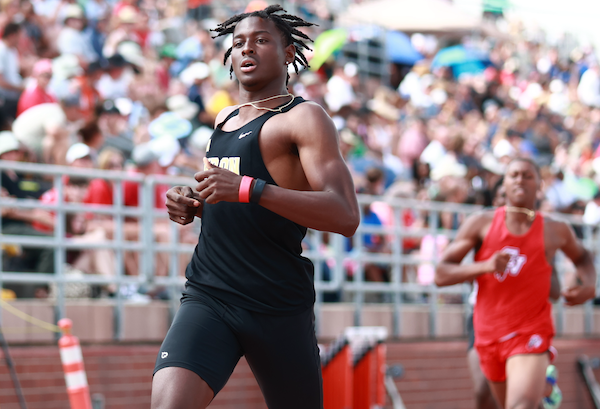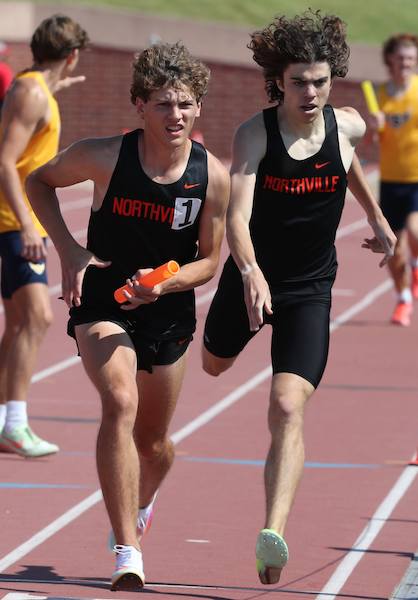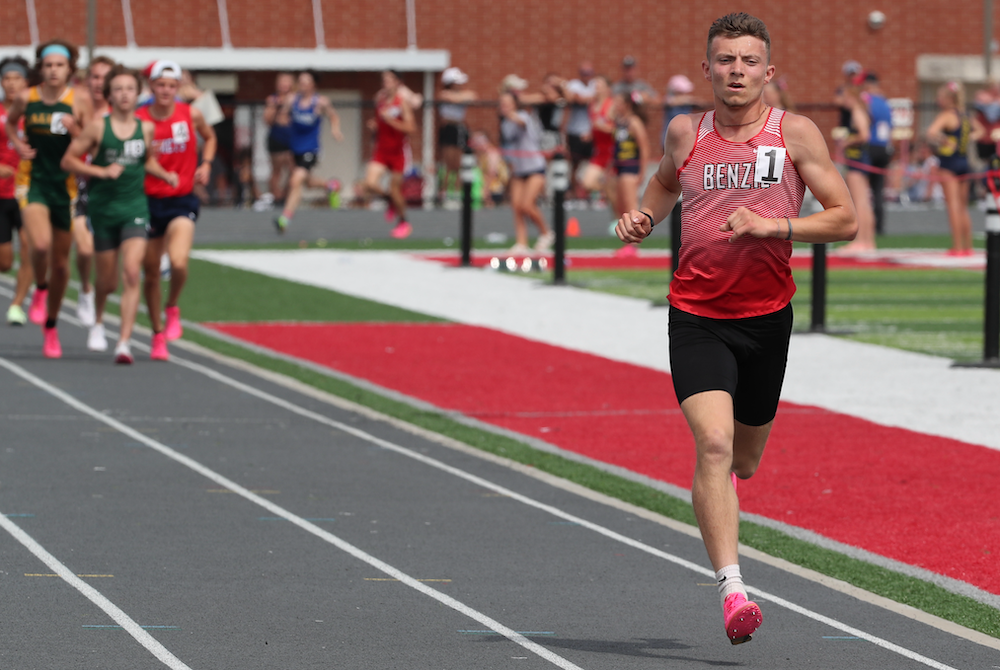
St. Joseph Boys Make Every Point Count in Clinching 1st Finals Since 1997
By
Keith Dunlap
Special for MHSAA.com
June 3, 2023
ROCKFORD – Entering the final event of Saturday’s Lower Peninsula Division 1 Final, the 1,600 relay, St. Joseph was in first place – but by the slimmest of margins.
St. Joseph had 35.75 points, while Rockford had 35, Clinton Township Chippewa Valley had 32, and Ann Arbor Huron had 30.
Bears head coach Todd Rose knew his team was in the second heat before faster teams after, but his for sure needed to be faster than Rockford.
“I don’t teach them to worry about who they are running against,” Rose said. “Just run within themselves and run how we teach them.”
St. Joseph did that behind the team of Shay White, Will Fiesbeck, Eli Toney and Alex Moyer, finishing fourth in the event with a time of 3:21.50 to earn a meet-best 40.75 points – clinching the program’s first Finals team championship since 1997.
Chippewa Valley was runner-up with 38 points, while Rockford was third at 36 points.
St. Joseph senior Gerald Capaccio scored 18 precious points for his team, most notably winning the discus with a winning throw of 167-2. Capaccio said he was in second going into his last throw.
 “I just had the mindset that everyone can have a big throw, and it just has to be me that gets the big throw,” Capaccio said. “It happened on my final throw.”
“I just had the mindset that everyone can have a big throw, and it just has to be me that gets the big throw,” Capaccio said. “It happened on my final throw.”
Capaccio also was second in the shot put with a throw of 56-11¼.
In addition to Capaccio earning big points in the shot put and discus, Rose gave credit to high jumper Joshua Scott for finishing in a tie for seventh in that event. That gave the Bears two points, and they proved to be especially important as the team won by less than one.
It’s rare when a runner does something that hasn’t been achieved since before automobiles were invented, but Ann Arbor Huron senior Braxton Brann had that distinction.
Brann won the 110 hurdles and the 200 dash, becoming the first athlete to win those two events at the same state meet since 1895 – three decades before the MHSAA was formed.
“It’s great to be in that kind of conversation,” said Brann, who will run in college at Ohio State.
First, Brann won the 110 hurdles in a time of 13.77. He said that was the event he was most concerned about.
“I haven’t really been consistent, so I just wanted to be that,” Brann said.
Feeling much more comfortable and at home in the 200 dash, Brann ran a winning time of 21.12.
“Everybody comes in looking at the stats of everybody else,” he said. “I saw I was in the best position to win. But I knew I had to run by butt off against this great field and come out with a win.”
 Just about everyone in the stadium did a double-take when Northville’s 3,200 relay time was posted. The team of Brandon Latta, Brock Malaikal, David Whitaker and Brendan Herger set a new all-Finals record with a blistering time of 7:35.32, which was the best time in the nation this year.
Just about everyone in the stadium did a double-take when Northville’s 3,200 relay time was posted. The team of Brandon Latta, Brock Malaikal, David Whitaker and Brendan Herger set a new all-Finals record with a blistering time of 7:35.32, which was the best time in the nation this year.
Herger said when he got the baton on the anchor leg, he knew his teammates set him up incredibly well. But even he and Northville couldn’t have foreseen this.
“I had to run 1.54 to get it, and then I ended up running a bit faster than that,” Herger said. “I was so happy. I love my boys so much. It was great to share the moment together.
Herger also ended up finishing second in the 800 meters with a time of 1:52.19 behind Utica’s Trent McFarland.
Detroit U-D Jesuit senior Jaiden Reed won the 100 (10.74), and Clinton Township Chippewa Valley junior Shamar Heard won the 400 (47.78). Grand Rapids Ottawa Hills senior Benne Anderson won the 1,600 (4:05.44), and Grand Haven junior Seth Norder won the 3,200 (9:04.68). Kalamazoo Central senior Kayenn Mabin won the 300 hurdles (38.31). Rockford in the 400 (42.01), Chippewa Valley in the 800 (1:26.41) and Oak Park in the 1,600 (3:18.90) also won relay titles.
Battle Creek Lakeview senior Andrew Berryhill was champion in the shot put (58-¼), and Saline senior Dolan Gonzales won pole vault (16-0). Ann Arbor Huron junior Andrew Harding won the high jump (6-7), and Canton sophomore Quincy Isaac won the long jump (22-11). New Baltimore Anchor Bay sophomore Luke Bowman competed in the adaptive 100 (19.65), 200 (35.66) and 400 (1:14.39).
PHOTOS (Top) St. Joseph celebrates its LPD1 championship Saturday. (Middle) Ann Arbor Huron's Braxton Brann finishes one of his two race wins. (Below) Northville makes the final exchange of its record-setting 3,200 relay. (Photos by Jamie McNinch [top two photos] and Carter Sherline/RunMichigan.com.)

Jones Era Ends with 3 More Race Wins - But Better Yet, Benzie's 1st Team Title
By
Scott DeCamp
Special for MHSAA.com
June 4, 2023
KENT CITY – For four years of MHSAA cross country and track, Benzie Central’s boys runners and competitors alike have been trying to keep up with the Joneses.
Specifically, Benzie Central senior All-American Hunter Jones.
Well, Pol Molins lives with the Joneses (Hunter’s family) as a foreign-exchange student from Spain. Over the last few months, Molins has done a better job keeping up with Hunter Jones.
Now Jones, Molins and their Benzie Central teammates are all on the same level – as MHSAA Lower Peninsula Division 3 champions. The Huskies captured their first MHSAA Boys Track & Field Finals title, powered by Jones’ three individual championships along with strong efforts by Molins & Co. at Kent City High School.
Benzie Central totaled 51 points to hold off runner-up Pewamo-Westphalia, which tallied 44 points. Hart finished third (38), Sanford Meridian fourth (36) and Ottawa Lake Whiteford fifth (28).
“I’m very proud of myself, but ultimately my biggest goal today was to win a team state championship. We came out here, that’s what we did,” said Jones, a 6-foot, 160-pound Wake Forest signee, who cruised to victories Saturday in the 800-meter run (1:57.60), 1,600 run (4:17.48) and 3,200 (9:10.19).
Jones expressed much gratitude for not only Molins – who earned valuable points by taking second in the 1,600, fifth in the 3,200 and seventh in the 800 -- but for the other two runners on Benzie Central’s runner-up 3,200 relay team: Lucan Louwsma and Dorian Olson.
Benzie Central veteran coach Asa Kelly said Olson had never competed at Finals track meet before, and that this was the first time this foursome had run the 3,200.
“I really praise the 4x8 – those other two guys, they put us in the race and we got those eight points we needed,” Jones said. “If we didn’t run the 4x8, we would have lost. I thank those guys and I feel very blessed to finally get a team state championship. That’s been my biggest goal since I’ve gotten to Benzie.”
 That’s a big statement coming from a generational runner who closes his MHSAA career with 10 individual Finals championships: four in Division 3 cross country and six in track & field.
That’s a big statement coming from a generational runner who closes his MHSAA career with 10 individual Finals championships: four in Division 3 cross country and six in track & field.
Jones is a multiple-time national champion in various events as well as an indoor state champ numerous times. He holds MHSAA LP Division 3 Finals records in the 800 and 1,600, and he missed the Finals record in the 3,200 on Saturday by 1½ seconds.
After he learned Benzie Central had wrapped up the team title, he said he didn’t even care if he had won any events Saturday.
“It’s an overwhelming feeling, you know,” Jones said. “A couple of minutes ago, I was getting tears in my eyes and I was like, ‘It’s all over now.’ But I’m really happy that it ended with this and I couldn’t have asked for anything better. I’m very, very happy.”
There was plenty of joy to go around Saturday. North Muskegon junior Jerry Wiegers, who was making his Finals debut, raced to victories in the 200 and 400 with personal-record times in both. In the 200, he won with a time of 22.11 seconds. In the 400, he finished first with a time of 49.49.
Wiegers also anchored North Muskegon’s 800 relay team that placed seventh (1:32.44) for all-state honors.
“Yeah, I’m still processing it,” Wiegers said. “It’s just, like, a good feeling to have when all the work you put in through the whole year finally comes to a close out of everyone. I’ve been waiting to do this for a long time.”
It was a bit of a “bittersweet” day for Hart senior standout thrower Kellen Kimes. The Liberty University signee defended his Division 3 title in discus with a toss of 174 feet, 3 inches, but he came up just short in winning the shot put with a second-place toss of 57-¼.
It was the second-straight year Kimes finished runner-up in shot put, but the New Balance Indoor national champion in the weight throw was trying to keep proper perspective.
“I’m pretty sad that it’s over. I’ve got two more meets this year with the high school events, but from then on I’m going to be moving to college (competition),” Kimes said. “It’s easy to be, like, ‘OK, next chapter in my life,’ but I do need to spend some time reflecting on it and just realizing just how blessed I am with all the people that God’s put in my life.”
Kimes is a fierce competitor, but he’s always willing to help others, including his direct competition.
That was the case with Pewamo-Westphalia junior Gavin Nurenberg, who launched a personal record in shot put by two feet with an effort of 57-¼ that edged Kimes.
“I mean, it means a lot. It’s just, we were competitors – honestly, he taught me the most out of anybody in shot put,” Nurenberg said. “Like, this guy is telling me, get like certain cues and stuff and I do credit him for some of that for sure.”
Other champions Saturday included: Warren Michigan Collegiate’s Jailin Spikes in the 100 (10.71 PR), Napoleon’s Holden Van Poppel in the 110 hurdles (14.48 PR), Delton Kellogg’s Torren Mapes in the 300 hurdles (40.01 PR), Meridian’s Sawyer Moloy in high jump (6-4), Ovid-Elsie’s Tryce Tokar in pole vault (15-0), Grayling’s Mitchel Harrington in long jump (22-1.75), Meridian’s 400 relay (Kenneth Emmerson, Madix Saunders, Nickolas Metzer and Brayden Riley; 43.47), Burton Atherton’s 800 relay (Romiel Clausell, Joseph Embury, Jaymes Vines, Patrick Rice; 1:30.51), Whiteford’s 1,600 relay (Shea Ruddy, Ryin Ruddy, Dylan Anderson, Jacob Iott; 3:27.28), and Hart’s 3,200 relay (Clayton Ackley, Seth Ackley, Guillermo Ortega, Wyatt Dean; 8:04.54). Grosse Pointe Woods University Liggett junior Jake Juip won the adaptive 100 race (1:04.21), and Perry junior Alec Chapman competed in the adaptive shot put (3-8¼).
Benzie Central was the Division 3 runner-up in 2021 and 2001. This time, the Huskies got over the hump.
Dominant as Jones was, Molins provided quite the boost in the way of quality depth.
“It’s crazy with Pol (when he applied to be an exchange student) – they said he liked to run and he checked off track & field as an interest, but can’t find anything else about the kid,” Kelly said with a smile. “… In cross, he was maybe like 23rd (in the state) or something like that, but then over the course of the winter running every day with Hunter, he just exploded.”
Kelly said that Molins will head back to Spain in a few weeks and he’ll race in the Spanish U18 Nationals. Kelly noted that after this season with Benzie Central, Molins is ranked second in Spain for his division in the 1,500 and 800.
Molins, a sophomore who recently turned 16 years old, said he could not have asked for a better experience or better host family than the Joneses.
“They’ve pushed me in every way,” he said. “I’ve learned lots of stuff, a lot of discipline. I’ve worked a lot, put in a lot of miles. All of this, I’m going to take it to Spain. I’m going to get better and if I can, I’m going to come back in a couple of years for college. It would be great.
“I’m really grateful,” added the lanky, 6-foot-3 Molins. “l couldn’t have asked for a better experience. I’m looking forward to coming back one day and checking on everyone, how they are doing.”
(PHOTOS) Benzie Central’s Hunter Jones, far right, leads one of his races by a significant margin Saturday at Kent City. (Middle) Teammate Pol Molins, second from right and leading the rest of the field, follow Jones. (Photos by Carter Sherline/RunMichigan.com.)

